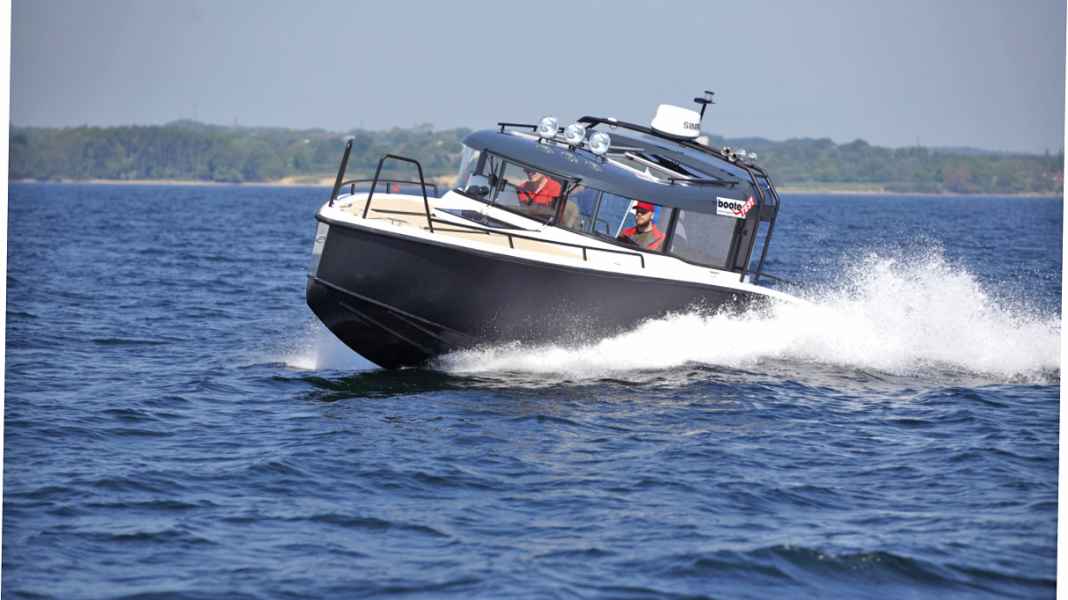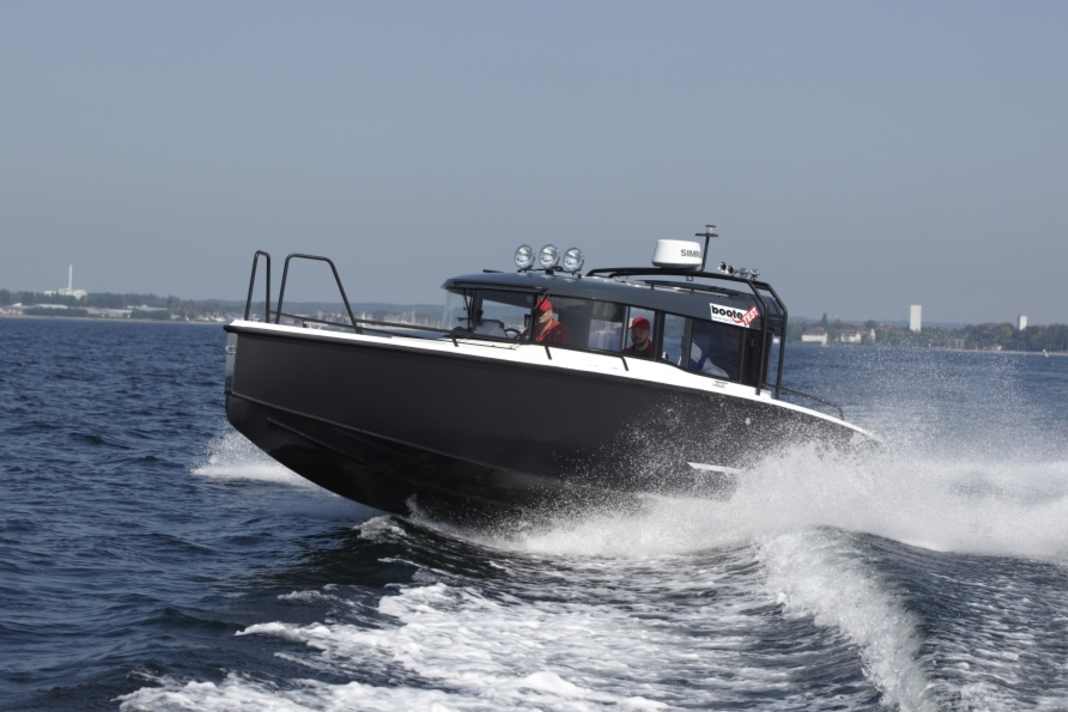







Anyone who visits the XO-Boats website will find the following under the company philosophy: "The company is innovative, powerful, has a unique style and shows attention to detail. All points that are clearly visible in our entire model range." We can only confirm the latter when we look at our test boat. The dominant driver's cabin with seating area is just as much a part of this as the dark design and open cockpit. Another special feature is the construction method: A hull made of special aluminium and an attached deck mould made of fibreglass-reinforced plastic are used here.

With the exception of a few details, the boat builders have done a good job during production. Examples of this include clean weld seams, deburred cut-outs, sturdy upholstery covers and solidly bolted handrails. The technicians in the engine compartment and under the driving position worked with the same care.
Our test boat is equipped with a diesel inboard engine; XO Boats also offers a "270 OB version" with an outboard engine. The installed D4-300 from Volvo Penta is the standard engine. As an extra, our test candidate is equipped with a trim assistant. This means that once set, the driver no longer has to worry about the correct trim setting for the power trim and flaps. If you start in automatic mode, you have good foresight in the transition range and the XO starts to glide from 2000 rpm.
Without the automatic system, the bow lifts further and the transition is noticeably longer, but the test boat enters the planing range without any problems even without trim tab actuation. Of course, the automatic system also has the advantage that it always brings the boat into the optimum position over the entire planing range. The XO thus makes good, course-stable sailing from around 2250 rpm (21.2 kn), which also characterises the most economical sailing. With a consumption of 1.13 l/sm and 315 litres of fuel, this results in a range of a remarkable 237 nm plus 15% reserve. At full throttle (38.2 kn) there are still 179 nm possible.
If you take fast bends in this driving position, you won't be in for an unpleasant surprise, as the body turns smoothly and safely in automatic mode. The same applies on slalom courses and with abrupt steering movements. Without the trim assistant, the XO behaves somewhat more sensitively.
The boat also cuts a fine figure in rough water. It skips the short, steep choppy waves of the Baltic Sea off Neustadt smoothly and dryly. Another plus: the hull always stays on track, even across the wave.
The XO 27 also demonstrates the latter on slow courses, where straight-ahead travel only needs to be corrected slightly from time to time. However, this does not mean that it is sluggish when manoeuvring. On the contrary, tight turning circles and direct steering behaviour guarantee manoeuvrability, and the bow thruster (extra) on our test boat does the rest.
But the best is yet to come: anyone who performs the manoeuvres in a seated position will feel completely at ease, as the installed grammers seat leaves nothing to be desired in terms of comfort. The only downer: the seat costs 950 euros extra. The front passenger sits on a wide bench seat, which can be folded down to form a reclining surface. The shipyard has installed two handles so that you can hold on to the side or front, depending on your preference.
Back to the driver: he has a firm grip on the height-adjustable, thick sports steering wheel. To operate the gearstick while standing, the driver has to lean down a little, but in this situation he has a good view of the instruments. An untinted safety glass windscreen, two sufficiently large windscreen wipers and defroster nozzles directly in front of the windscreen ensure a clear view to the front.
The diesel stands on solid aluminium foundations under a huge flap with two durable gas pressure dampers. There is plenty of room for the service technician to manoeuvre and a fire extinguishing system provides the necessary safety in the event of a fire. The shipyard foams the sturdy aluminium tank into the bilge and expertly secures the hose lines with two clamps. A filter on the engine and an additional filter cartridge with drain plug are responsible for cleaning the fuel. Another plus: the batteries are located in ventilated boxes and are switched via two main switches, which are conveniently located next to the driver's seat. The circuit breakers are right next to them. The 230 V shore connection via the isolating transformer, which protects against galvanic corrosion, is first class. The other safety equipment includes an electric bilge pump, hand bilge pump and 2 kg fire extinguisher (stowed in the stowage box on the starboard side).
To ensure safe movement on board, the shipyard has provided the floor with non-slip structures and sturdy handrails provide the necessary support. However, the designer has designed the cockpit to be open aft, and there is no barrier as standard, which is not only dangerous for children. If you accelerate without warning, you risk throwing the rear guests off. Bathing enthusiasts can exit the boat via a long ladder, which can also be easily operated from the water. Simple benches are available for sitting in the cockpit.
The saloon is accessed via a sliding door with locking mechanism. There is a seating area that can be converted into a berth. With a width of 0.98 m, it is large enough for two children, but cramped for adults. In the bow, the two berths are separated at the entrance area and only come together in the front third. This is because the exit to the foredeck with steps and hatch is located in the centre. There is plenty of storage space on the boat. There is a large storage locker on the port side of the standard boat. On our test boat, however, the optional wet cell was installed there.
The cell has an electric toilet, a moderate amount of space and only the entrance door provides ventilation. The strip light in the ceiling provides light, but cannot be opened. The hatches in the saloon are different, allowing you to "catch" the sun and keep everything well ventilated. If you want to prepare snacks, you can order an extra galley unit. The list of accessories also includes an anchor windlass, navigation instruments, teak design and heating (Webasto).
The bottom line
The XO 270 FC is more of a cruising machine than a cabin cruiser for long journeys. Although it can sleep up to four people in moderately spacious accommodation, additional living comforts such as a toilet and galley cost extra. We didn't like the open aft cockpit. Convincing on the other hand: the workmanship and driving performance.
Data sheet: XO 270 RS Front Cabin
Shipyard: XO Boats
Type designation: XO 270 RS Front Cabin
CE category: C - Coastal waters
Length: 8,60 m
Width: 2,60 m
Displacement: 3,00 t
Price: 144.999,00 €

